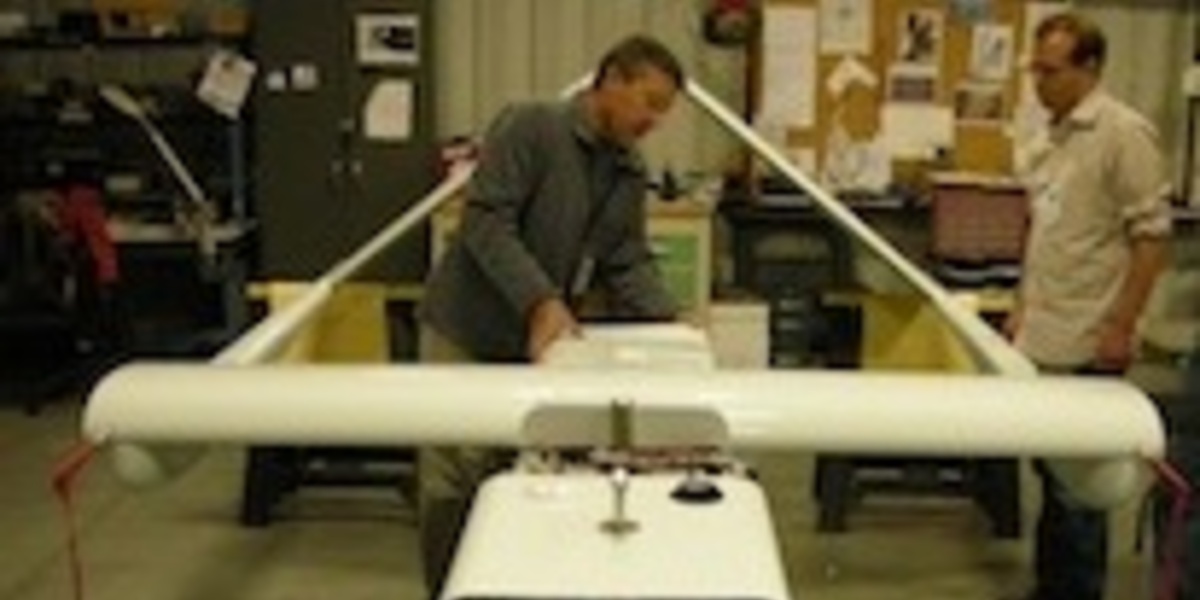I've got two simple yet evocative phrases for you. Wing pods. Unmanned Aerial Vehicles. Excited? We are. During late June, a team of top scientists from the NASA Ames Research Center deployed three Picarro analyzers as part of the The Railroad Valley Vicarious Calibration Campaign, a collaboration between the Japan Aerospace Exploration Agency (JAXA), and NASA's Jet Propulsion Laboratory (JPL), Pasadena, Calif. One of the analyzers was deployed in a wing pod of an Alpha jet which flew up to altitudes of 25,000 feet. Another was deployed in the nose cone of an Unmanned Aerial Vehicle. The third one was on the ground in a tent. We are getting data back from this exercise and its impressive. Pictured here is NASA Payload Integration Engineer Richard Kolyer (left) showing Picarro Director of R&D Chris Rella (rigth) the UAV rig in a hangar at NASA Ames. Also, I wanted to add that this was one of the first campaigns for Picarro's new flux instrument, which automatically synchs with a sonic anemometer. Early reports coming back are extremely positive from beta users. Read the NASA press release in full below - lots of great information.
"The Railroad Valley Vicarious Calibration Campaign, a collaboration between the Japan Aerospace Exploration Agency (JAXA), and NASA's Jet Propulsion Laboratory (JPL), Pasadena, Calif., is an international, multi-year effort to calibrate space-based observations of carbon dioxide and methane collected by the Japanese Greenhouse Gases Observing Satellite (GOSAT), using ground and airborne data. The campaign is based at Railroad Valley, on a dry lake bed, or playa, about 75 miles southwest of Ely, Nev. It involves more than 30 scientists and engineers from JAXA, the University of Wisconsin, Madison, Colorado State University, Fort Collins and JPL. The Ames team supported the effort by providing ground and airborne measurements of carbon dioxide and methane. In addition, for the first time this year, the Ames team also investigated local sources of halophiles organisms that live in evaporated ponds where there are extreme concentrations of salts.
"We are pleased to offer these observations to our Japanese and Jet Propulsion Laboratory colleagues in support of the important task of very precisely measuring greenhouse gases from space. We look forward to continuing to support the GOSAT team and the upcoming NASA Orbiting Carbon Observatory -2 (OCO-2) mission," said Laura Iraci, an Earth science researcher from the Atmospheric Science Branch at Ames who planned and implemented the Ames effort.
During the campaign, the Ames team conducted a series of flights with an unmanned aircraft system (UAS), a modified Alpha Jet and a NASA ER-2 Earth resources aircraft, outfitted with AVIRIS, MASTER, and S-HIS instruments. NASA's ER-2 high-altitude aircraft flew over Railroad Valley carrying MASTER, AVIRIS and a digital camera system at an altitude of 65,000 feet complementing data collected by the other two aircraft at lower altitudes.
The UAS, known as the Sensor Integrated Environmental Remote Research Aircraft (SIERRA), carried sensors to measure greenhouse gases and winds and flew at altitudes of 100-2,500 feet above ground. The SIERRA flew two measurement missions: one to determine vertical profiles of carbon dioxide over the base camp on the playa, and measurements across the playa at low altitudes, and the second to map sources of natural and biogenic methane. SIERRA, which is operated out of Ames, flew from a public airstrip at Currant Ranch, Nev.
The second aircraft, an Alpha Jet, owned and operated by H211, LLC, flew to the Railroad Valley site from Ames and made a downward spiral around the base camp site. The spiral had a top altitude of approximately 25,000 feet, a bottom altitude near 5,000 feet, and an approximate three mile radius. The vertical profile took approximately 20 minutes to complete.
Ground observations showed what appeared to be bursts of carbon dioxide and methane from the soil of the salty lakebed. Preliminary tests suggest a possible surface, or subsurface, source for these gas emissions. These findings are important to both Earth and planetary scientists: greenhouse gases contribute to global warming, and recent scientific findings of Mars¹ surface suggest evidence that there were large bodies of salt water in the past. Both perspectives emphasize a need to further investigate these types of environments for past and present life. For example, methane has been reported in the atmosphere of Mars, and is known to be produced by microbial mats that are present in the most salty environments on Earth.
To study the source of gas emissions, Chris McKay and Brad Bebout, space science researchers from Ames, led a team to observe biogenic and non-biogenic sources of methane in the Railroad Valley area. Using data loggers inserted near the surface and at depths of 20 and 30 cm to monitor the temperature and moisture of the soil, the space team collected soil and gas samples for further study in the laboratory. In addition, the SIERRA flew over potential methane sources on June 18 and 21, while the ground-based team collected concurrently carbon dioxide observations on the ground June 21.
"Although there is a general understanding of the natural and anthropogenic sources and sinks of carbon dioxide and methane, their fluctuations must be better quantified to better forecast and mitigate global climate change. These measurements over the dry, salt flat will help us better measure the spatial distribution and heterogeneity of greenhouse gases," said Bebout.
This work also is important to NASA's goals in Astrobiology. Methane has been reported on Mars and pinpointing sources and determining whether or not the methane is biogenic will also be important there. According to Bebout: "We can use Railroad Valley and other Mars analogue sites to help interpret methane data to be returned from upcoming Mars missions, including Mars Science Laboratory and the 2016 ExoMars Trace Gas Orbiter."
